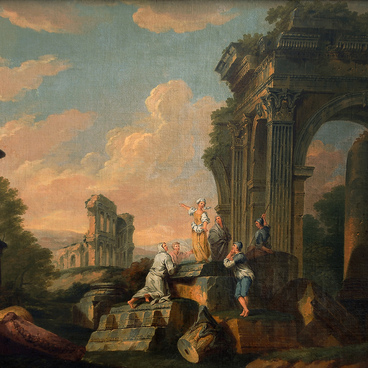The painting “The Annunciation to the Shepherds” entered the Primorye Art Gallery as attributed to Jacopo dal Ponte, nicknamed Bassano — after the name of the city where he was born and spent all his life. Later, the staff of the State Hermitage Museum, comparing the composition with the works of Jacopo Bassano, did not find a similar plot in the artist’s legacy and suggested that it might have been painted by one of his sons. Leandro Bassano (1557–1622) had a very similar painting, only mirrored in relation to the one under study. In order to accurately determine the painter, the work must undergo an examination in the future.
Leandro Bassano is a representative of the Venetian Terraferma school. Terraferma — the Italian for “solid land” — was the name for the mainland possessions of the Venetian Republic on the Adriatic coast of northeastern Italy. The way of life in the province was very different from the Venetian one, which determined the uniqueness of the local art school, despite its proximity to the school of the metropolis. The art of the Terraferma, with its tranquility and interest in the life of a common man, contrasted with the glamorous art of noisy Venice.
Leandro is one of the four sons of Jacopo Bassano, the most important of the Terraferma artists. Like his father, he was influenced by the Venetian painter Tintoretto. He created paintings mainly on religious subjects but was also known as a portraitist. Leandro, like most of the Terraferma artists, makes an ordinary individual — his countryman and contemporary — the hero of his paintings. It is no coincidence that among his favorite themes were the subjects of the Christmas cycle: the annunciation to the shepherds and the worship of the shepherds.
“The Annunciation to the Shepherds” is a pastoral scene with deep symbolic meaning: it forms one of the first links connecting the Old and New Testaments. The Old Testament patriarchs were shepherds who received their revelations in the pasture, among the flocks. The angel who announced the birth of Christ is traditionally considered to be the archangel Gabriel. The number of shepherds depicted in this scene varies. Most often there are three of them — by analogy with the three Magi. Three shepherds often symbolize the three ages of man. In Leandro’s “Annunciation”, the angelic glow merges with the light from the star, illuminating the pastoral scene and the somber landscape. In “The Annunciation to the Shepherds” one can see how, with the change of the worldview in painting, new principles of true-to-life depiction of the world and man were formed.
Leandro Bassano is a representative of the Venetian Terraferma school. Terraferma — the Italian for “solid land” — was the name for the mainland possessions of the Venetian Republic on the Adriatic coast of northeastern Italy. The way of life in the province was very different from the Venetian one, which determined the uniqueness of the local art school, despite its proximity to the school of the metropolis. The art of the Terraferma, with its tranquility and interest in the life of a common man, contrasted with the glamorous art of noisy Venice.
Leandro is one of the four sons of Jacopo Bassano, the most important of the Terraferma artists. Like his father, he was influenced by the Venetian painter Tintoretto. He created paintings mainly on religious subjects but was also known as a portraitist. Leandro, like most of the Terraferma artists, makes an ordinary individual — his countryman and contemporary — the hero of his paintings. It is no coincidence that among his favorite themes were the subjects of the Christmas cycle: the annunciation to the shepherds and the worship of the shepherds.
“The Annunciation to the Shepherds” is a pastoral scene with deep symbolic meaning: it forms one of the first links connecting the Old and New Testaments. The Old Testament patriarchs were shepherds who received their revelations in the pasture, among the flocks. The angel who announced the birth of Christ is traditionally considered to be the archangel Gabriel. The number of shepherds depicted in this scene varies. Most often there are three of them — by analogy with the three Magi. Three shepherds often symbolize the three ages of man. In Leandro’s “Annunciation”, the angelic glow merges with the light from the star, illuminating the pastoral scene and the somber landscape. In “The Annunciation to the Shepherds” one can see how, with the change of the worldview in painting, new principles of true-to-life depiction of the world and man were formed.




